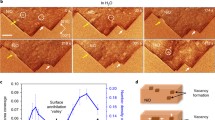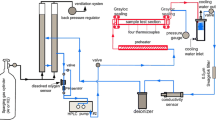Abstract
A principal mode of corrosion in combustion or fuel cell environments is the formation of volatile hydroxides and oxyhydroxides from metal or oxide surfaces at high temperatures. It is important to determine the degree of volatility and accurate thermodynamic properties for these hydroxides. Significant gaseous metal hydroxides/oxyhydroxides are discussed, along with available experimental and theoretical methods of characterizing species and determining their thermodynamic properties.











Similar content being viewed by others
References
O. Glemser and H.G. Wendlandt: Gaseous hydroxides. In Advances in Inorganic Chemistry and Radiochemistry, Vol. 5, H.J. Emeléus and A.G. Sharpe, eds., pp. 215–258 (Academic Press, New York, 1963).
J.W. Hastie: High Temperature Vapors Science and Technology (Academic Press, New York, 1975); pp. 60–87.
P.J. Meschter, E.J. Opila, and N.S. Jacobson: Water vapor mediated volatilization of high temperature materials. In Annual Reviews of Materials Research, D.M. Lipkin, ed. (Annual Reviews, Inc., Palo Alto, 2013).
N.S. Jacobson: High-temperature durability considerations for HSCT combustor. NASA TP-3162 (1992).
I. Glassman: Combustion, 2nd ed. (Academic Press, Inc., Orlando, 1987).
E.J. Opila and D.L. Myers: Alumina volatility in water vapor at elevated temperatures. J. Am. Ceram. Soc. 87, 1701–1705 (2004).
E.J. Opila and D.L. Myers: Alumina volatility in water vapor at elevated temperatures: Application to combustion environments. In High Temperature Corrosion and Materials Chemistry IV, E. Opila, P. Hou, T. Maruyama, B. Pieraggi, D. Shifler, and E. Wuchina, eds. (The Electrochemical Society, Inc., Pennington, New Jersey, 2003); pp. 535–544.
J.W. Fergus: Effect of cathode and electrolyte transport properties on chromium poisoning in solid oxide fuel cells. Int. J. Hydrogen Energy 32, 3664–3671 (2007).
D.J. Young and B.A. Pint: Chromium volatilization rates from Cr2O3 scales into flowing gases containing water vapor. Oxid. Met. 66, 137–153 (2006).
A. Kantrowitz and J. Grey: A high intensity source for the molecular beam. I. Theoretical. Rev. Sci. Instrum. 21, 328 (1951).
T.A. Milne and F.T. Greene: Direct mass spectrometric sampling of high pressure systems. In Mass Spectrometry in Inorganic Chemistry, J.L. Margrave, ed. (ACS, Washington DC, 1968); ch. 5, pp. 68–82.
C.A. Stearns, F.J. Kohl, G.C. Fryburg, and R.A. Miller: A High Pressure Modulated Molecular Beam Mass Spectrometric Sampling System: NASA Technical Memorandum 73720 (National Aeronautics and Space Administration, Washington, DC, 1977).
E.J. Opila, D.S. Fox, and N.S. Jacobson: Mass spectrometric identification of Si—O–H(g) species from the reaction of silica with water vapor at atmospheric pressure. J. Am. Ceram. Soc. 80, 1009–1012 (1997).
D.L. Myers and N.S. Jacobson: Identification of volatile metal hydroxides with free jet expansion mass spectrometry. In Proceedings of International KEMS Workshop, D. Kobertz, N. Jacobson, and D. Sergeev, eds., Calphad Special Issue, in press (Juelich, Germany, 2017).
D. Myers, M. Kulis, J. Horvath, N. Jacobson, and D. Fox: Interactions of Ta2O5 with water vapor at elevated temperatures. J. Am. Ceram. Soc. 100, 2353–2357 (2017).
G.C. Fryburg, R.A. Miller, F.J. Kohl, and C.A. Stearns: Volatile products in the corrosion of Cr, Mo, Ti, and four superalloys exposed to O2 containing H2O and gaseous NaCl. J. Electrochem. Soc. 124, 1738–1743 (1977).
J.W. Hastie, K.F. Zmbov, and D.W. Bonnell: Transpiration mass spectrometric analysis of liquid KCl and KOH vaporization. In Modern High Temperature Science, J.L. Margrave, ed. (Humana Press, Totowa, NJ, 1984); pp. 333–364.
E.J. Opila, D.L. Myers, N.S. Jacobson, I.M.B. Nielsen, D.F. Johnson, J.K. Olminsky, and M.D. Allendorf: Theoretical and experimental investigation of the thermochemistry of CrO2(OH)2(g). J. Phys. Chem. A 111, 1971–1980 (2007).
J.M. Bassler and J.L. Margrave: High-temperature applications of infrared spectroscopy. In The Characterization of High Temperature Vapors, J.L. Margrave, ed. (John Wiley & Sons, Inc., New York, 1967); pp. 264–281.
W. Weltner, Jr.: The matrix-isolation technique applied to high temperature molecules. In Advances in High Temperature Chemistry, Vol. 2., L. Eyring, ed. (Elsevier, New York, 1969); pp. 85–105.
X. Wang and L. Andrews: Infrared spectroscopic observations of the group 13 metal hydroxides, M(OH)1,2,3 (M = Al, Ga, in, and Tl) and HAl(OH)2. J. Phys. Chem. A 111, 1860–1868 (2007).
X.F. Wang and L. Andrews: Infrared spectra for group 4 dihydroxide and tetrahydroxide molecules. J. Phys. Chem. A 109, 10689–10701 (2005).
L. Shao, L. Zhang, M. Chen, H. Lu, and M. Zhou: Reactions of titanium oxides with water molecules. A matrix isolation FTIR and density functional study. Chem. Phys. Lett. 343, 178–184 (2001).
J.H. Jensen: Molecular Modeling Basics (CRC Press, Boca Raton, 2010).
U. Merton and W.E. Bell: The transpiration method. In The Characterization of High Temperature Vapors, J.L. Margrave, ed. (John Wiley & Sons, Inc., New York, 1967); p. 91.
G.R. Belton and F.D. Richardson: A volatile iron hydroxide. Trans. Faraday Soc. 58, 1562–1572 (1962).
G.R. Belton and R.L. McCarron: The volatilization of tungsten in the presence of water vapor. J. Phys. Chem. 68, 1852–1856 (1964).
G.R. Belton and A.S. Jordan: The volatilization of molybdenum in the presence of water vapor. J. Phys. Chem. 69, 2065–2071 (1965).
G.R. Belton and A.S. Jordan: The gaseous hydroxides of cobalt and nickel. J. Phys. Chem. 71, 4114–4120 (1967).
Y.W. Kim and G.R. Belton: The thermodynamics of volatilization of chromic oxide: Part I. The species CrO3 and CrO2OH. Metall. Trans. 5, 1811–1816 (1974).
A. Hashimoto: The effect of H2O gas on volatilities of planet forming major elements: I. Experimental determination of thermodynamic properties of Ca-, Al-, and Si-hydroxide gas molecules and its application to the solar nebula. Geochim. Cosmochim. Acta 56, 511–532 (1992).
N.S. Jacobson, E.J. Opila, D.L. Myers, and E.H. Copland: Thermodynamics of gas phase species in the Si—O–H system. J. Chem. Thermodyn. 37, 1130–1137 (2005).
J. Drowart and P. Goldfinger: Investigation of inorganic systems at high temperature by mass spectrometry. Angew. Chem., Int. Ed. 6, 581–596 (1967).
E.J. Opila, J.L. Smialek, R.C. Robinson, D.S. Fox, and N.S. Jacobson: SiC recession caused by SiO2 scale volatility under combustion conditions: II, thermodynamics and gaseous-diffusion model. J. Am. Ceram. Soc. 82, 1826–1834 (1999).
O.H. Krikorian: Thermodynamics of the silica-steam system. In Symposium on Engineering with Nuclear Explosives (Las Vegas, Nevada, 1970). (unpublished).
C.L. Darling and H.B. Schlegel: Heats of formation of SiHnO and SiHnO2 calculated by ab initio molecular orbital methods at the G-2 level of theory. J. Phys. Chem. 97, 8207–8211 (1993).
M.D. Allendorf, C.F. Melius, P. Ho, and M.R. Zachariah: Theoretical study of the thermochemistry of molecules in the Si—O–H system. J. Phys. Chem. 99, 15285–15293 (1995).
A.V. Plyasunov: Thermodynamic properties of H4SiO4 in the ideal gas state as evaluated from experimental data. Geochim. Cosmochim. Acta 75, 3853–3865 (2011).
L.V. Gurvich, I.V. Veyts, and C.B. Alcock: Thermodynamic properties of individual substances: Elements O, H (D, T), F, Cl, Br, I, He, Ne, Ar, Kr, Xe, Rn, S, N, P and their compounds. Pt. 1. Methods and computation. Pt. 2. Tables. Vol. 1–2. Hemisphere, (1989) and Vol. 3, Begell House, Inc., New York (1989).
B.B. Ebbinghaus: Thermodynamics of gas phase chromium species: The chromium oxides, the chromium oxyhydroxides, and volatility calculations in waste incineration processes. Combust. Flame 93, 119–137 (1993).
M. Stanislowski, E. Wessel, K. Hilpert, T. Markus, and L. Singheiser: Chromium Vaporization from High Temperature Alloys I. Chromia-Forming Steels and the Influence of Outer Oxide Layers. J. Electrochem. Soc. 154, A295–A306 (2007).
Q.N. Nguyen, D.L. Myers, N.S. Jacobson, and E.J. Opila: Experimental and theoretical study of the reactions of titania and water at high temperatures. NASA/TM—2014-218372 (2014).
Q.N. Nguyen, C.W. Bauschlicher, Jr., D.L. Myers, N.S. Jacobson, and E.J. Opila: Computational and experimental study of thermodynamics of the reaction of titania and water at high temperatures. J. Phys. Chem. A 121, 9508–9517 (2017).
G.H. Geiger and D.R. Poirer: Transport Phenomena in Metallurgy, Vol. 532 (Addison-Wesley Publishing Co., Reading, Massachusetts, 1972).
S.L. dos Santos e Lucato, O.H. Sudre, and D.B. Marshall: A method for assessing reactions of water vapor with materials in high-speed, high-temperature flow. J. Am. Ceram. Soc. 94, 186–195 (2011).
R.A. Golden and E.J. Opila: A method for assessing the volatility of oxides in high-temperature high velocity vapor. J. Eur. Ceram. Soc. 36, 1135–1147 (2016).
K.A. Mueller, R.A. Golden, and E.J. Opila: High temperature behavior of Ta2O5 in water vapor. The Spectra, IX, 50–55 (2018).
O.H. Krikorian: Predictive calculations of volatilities of metals and oxides in steam containing environments. High Temp.-High Pressures 14, 387–397 (1982).
F.T. Greene: Applications of electronic spectroscopy to high-temperature systems. In The Characterization of High Temperature Vapors, J.L. Margrave, ed. (John Wiley & Sons, New York, 1967); pp. 300–358.
M.W. Chase, Jr.: NIST-JANAF Thermochemical Tables, 4th ed. Published by the American Chemical Society, the American Institute of Physics, and the National Institute of Standards and Technology. J. Phys. Chem. Ref. Data, Monograph No. 9 (1998).
A.V. Plyasunov, A.S. Zyubin, and T.S. Zyubina: Thermodynamic properties of Si(OH)4(g) based on experimental and quantum chemistry data. J. Am. Ceram. Soc. 101, 4921–4926 (2018).
J.M.L. Martin: Basis set convergence and performance of density functional theory including exact exchange contributions for geometries and harmonic frequencies. Mol. Phys. 86, 1437 (1995).
A.P. Scott and L. Radom: Harmonic vibrational frequencies: An evaluation of Hartree—Fock, moller—Plesset, quadratic configuration interaction, density functional theory, and semiempirical scale factors. J. Phys. Chem. 100, 16502–16513 (1996).
K.S. Pitzer and W.D. Gwinn: Energy levels and thermodynamic functions for molecules with internal rotation: I. Rigid frame with attached tops. In Molecular Structure and Statistical Thermodynamics: Selected Papers of, Kenneth S. Pitzer, ed. (World Scientific, Singapore, 1993); pp. 33–46.
E. Courcot, F. Rebillat, F. Teyssandier, and C. Louchet-Pouillerie: Stability of rare earth oxides in a moist environment at high temperatures—Experimental and thermodynamic studies. Part I: The way to assess thermodynamic parameters from volatilisation rates. J. Eur. Ceram. Soc. 30, 1903–1909 (2010).
E. Courcot, F. Rebillat, F. Teyssandier, and C. Louchet-Pouillerie: Stability of rare earth oxides in a moist environment at elevated temperatures—Experimental and thermodynamic studies: Part II: Comparison of the rare earth oxides. J. Eur. Ceram. Soc. 30, 1911–1917 (2010).
C.W. Bale, P. Chartrand, S.A. Degterov, G. Eriksson, K. Hack, R.B. Mahfoud, J. Melançon, A.D. Pelton, and S. Petersen: FactSage thermochemical software and databases. Calphad 26, 189–228 (2002).
Author information
Authors and Affiliations
Corresponding author
Rights and permissions
About this article
Cite this article
Myers, D.L., Jacobson, N.S., Bauschlicher, C.W. et al. Thermochemistry of volatile metal hydroxides and oxyhydroxides at elevated temperatures. Journal of Materials Research 34, 394–407 (2019). https://doi.org/10.1557/jmr.2018.425
Received:
Accepted:
Published:
Issue Date:
DOI: https://doi.org/10.1557/jmr.2018.425




